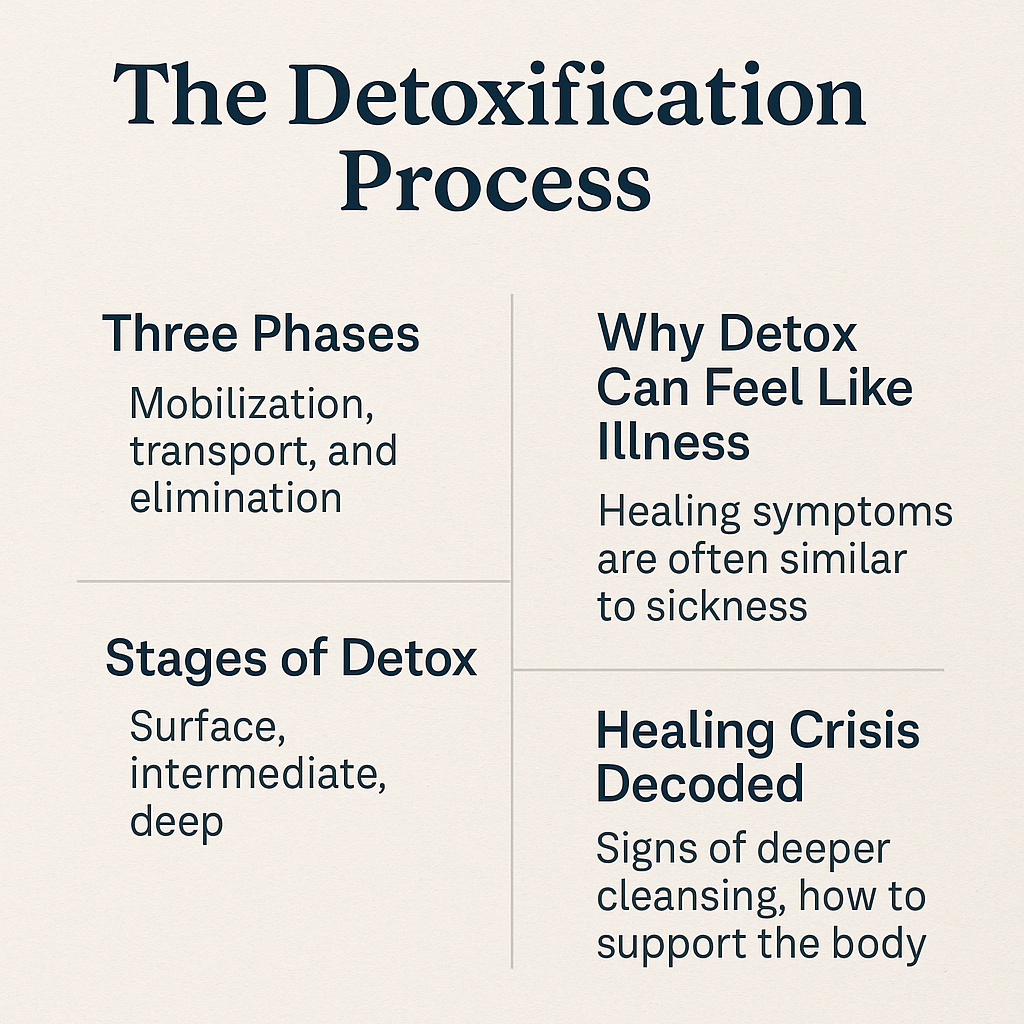Most people think of detoxification as a programme, a juice cleanse or something you must force the body to do. Yet from a Natural Hygiene viewpoint, detoxification is an ongoing biological process that never stops. Every cell in the body produces waste as part of its daily function. Every organ works to clear that waste. Under the right conditions, the body moves smoothly from mobilisation to elimination. When conditions are poor, waste becomes stored and symptoms appear.
This article explains the body’s three main detox phases, the deeper stages of cleansing, why detox can sometimes feel like illness, and what a healing crisis really means. When you understand detox, you stop fearing symptoms and begin to recognise them as part of the body’s intelligent design.
The Three Phases of Detoxification
The detoxification process is not random. It follows a clear pattern that repeats throughout life.
1. Mobilisation
In this first phase, the body identifies stored waste, toxins, acids and cellular debris and begins to loosen them. This can include mucus stuck in the respiratory tract, old metabolic byproducts in the tissues, chemical residues stored in fat cells and acidic waste lodged in joints and muscles.
Mobilisation requires energy. When the body has enough rest and enough of the right nutrients from fresh fruit and hydration, it signals that deeper detox can begin. When energy is low, mobilisation slows down and waste continues to accumulate.
2. Transport
Once the waste has been mobilised, it must be transported. The lymphatic system plays a key role here. It acts as the drainage network for the entire body. Unlike the bloodstream, which has the heart to pump it, the lymph relies on movement, breath, hydration and low internal toxicity.
The bloodstream also transports certain waste products to the liver and kidneys. During this phase, symptoms like fatigue, headaches or a sense of heaviness can appear because waste is literally on the move.
3. Elimination
In the final phase, the body clears waste through its natural elimination channels. The primary routes are the bowels, kidneys, lungs and skin. When these channels are working well, detox feels smooth and energising. When they are sluggish, the body may use alternative routes, such as the skin, which often leads to breakouts or rashes.
Elimination is the deciding factor in whether detox feels comfortable or difficult. If waste is leaving efficiently, the body feels lighter and clearer. If too much is moving and not enough is leaving, detox symptoms intensify.
The Stages of Detoxification
Detoxification does not happen in a single sweep. It unfolds in layers, each stage revealing the next.
Surface Level Detox
At this level the body clears digestive waste, simple mucus, excess sodium, minor inflammation and easy-to-reach residues. People often feel more energy, better digestion and clearer thinking. This is the stage most people reach when they simply clean up their diet.
Intermediate Detox
Here the body begins to address deeper residues. This may include environmental toxins, old mucus hardened in the sinuses, acidic deposits around joints, chemical build-up from years of processed foods and waste trapped in sluggish lymphatic areas. Symptoms can increase, but so can clarity.
Deep Cellular Detox
This stage occurs when the body finally has enough strength, hydration and physiological safety to release matter stored for years. Deep detox can temporarily feel more intense because the waste being moved is more substantial. This is where emotional release can also occur as old patterns held in the nervous system shift.
Each stage is a sign of progress, not regression. The body is simply working through the layers in the order that protects you.
Why Detox Can Feel Like Illness
One of the most misunderstood aspects of detoxification is that it often mimics illness. The body uses the same mechanisms to heal that it uses during common sickness: mucus expulsion, fever responses, increased rest, skin eruptions and temporary weakness.
Detox can feel like illness because:
• Waste is circulating before it exits.
• The lymphatic system is clearing faster than the kidneys and bowels.
• The body has redirected energy away from muscles and digestion and into repair.
• Toxins moving through the bloodstream can create short-term symptoms.
• The nervous system shifts into rest mode, which can feel like fatigue.
From a Natural Hygiene perspective, these symptoms are not threats. They are evidence of the body’s intelligence working at full capacity.
The Healing Crisis Decoded
A healing crisis is not a crisis in the medical sense. It is a period where the body finally has the conditions it needs to perform deeper detoxification. People often mistake it for getting worse, but it is usually a sign that the body has entered a more powerful healing phase.
A healing crisis is characterised by:
• A sudden increase in detox symptoms
• Temporary fatigue or weakness
• Intensified mucus, headaches or skin activity
• Emotional release as old tension clears
• Relief and clarity once the stage completes
The key difference between a healing crisis and true illness is that a healing crisis resolves with rest, hydration and continuation of natural living. Suppression slows the process. Support helps the body finish the job.
Supporting the Body Through Detox
To make detox smoother, focus on:
• Rest
• Hydration
• Fresh fruit and simple meals
• Reduced stress
• Natural light and fresh air
• Gentle movement
• Early nights
Detox is one of the body’s greatest gifts. When you stop fearing symptoms and begin to understand them, you step into partnership with your biology rather than resisting it.


